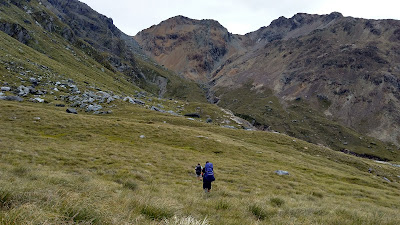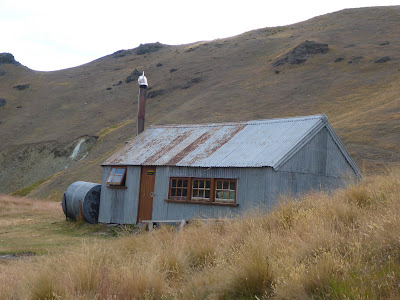| The ridgeline of day 2, traversed from right to left. |
The route had looked easy on the map: a couple of hours beside Irthing Stream to Mansion Hut the first night; straightforward, undulating ridge travel to Irthing Hut, and then a couple more days alternating between valley tracks and open tops, taking in Upper Cromel and Islands Huts, to complete the circuit. But now that seemingly easy ridge threatened to get the best of us.
The first day had gone to plan with a delightful meander up the valley to the tiny, humourously-named two-bunk Mansion Hut. There was not much living space inside so we opted to enjoy the calm, clear evening and soon had the campfire blazing outside.
 |
| Mansion Hut |
Brendan had gleefully promised lots of treats and surprises for my birthday and true to form he whipped up a delicious breakfast of pancakes with fresh strawberries and maple syrup! This was to be but the first of many little celebrations throughout the day. With bellies satisfied we waded across Irthing Stream and made our way up the spur immediately opposite the hut. The beech forest was relatively open so the going wasn’t too bad, although steep, and it only took about an hour to reach the bush line. Emerging into the open there was a bit of scrub to push through at first, before giving way to tussock and low shrubs. Point 1260, the first of five high points along the ridge, was soon reached only for us to immediately drop and regain 150m to the next peak.
While munching on fairy bread for lunch (after all, “What would a birthday be without fairy bread?”) it became apparent that the relentless heat was taking its toll on us. We were both wilting, and before us lay the daunting looking 450m haul up to Pt 1450. Beginning on the climb, the first warning signs of heat exhaustion began to loom threateningly. The tiny shadow of a large rock presented a brief respite before I haltingly continued upward through the knee-high shrubs. The route itself was not tricky, but what had promised to be a nice ridge walk was turning into a real struggle. Brendan jubilantly found a lingering patch of snow which we put to good use in topping up water bottles and cooling ourselves down, shoving handfuls down our backs and under our hats. Still the climb went on and the sun beat down. A small bluff provided just enough shade for us to collapse in for half an hour before tackling the final 100m. Although we were still not at the highest point on the ridge, reaching Pt 1460 was a huge relief, both physically and mentally, as from here the gradient was much gentler and there was snow to provide a bit of cooling.
| Descending to Shepherd Saddle |
After a brief break on the summit of Pt 1552 it was a straightforward descent to Shepherd Saddle, with a couple of small snow patches providing easy progress. From the saddle a nice scree shute dropped us 100m and then it was a descending traverse through tussock and shrubs down to the creek. What bliss to finally reach ice-cold, running water again! Half an hour through beech trees brought us out behind the bright orange Irthing Hut. According to the records in the hut book, only 12 people a year stay at this cosy two-bunk biv. A refreshing wash in the stream was first priority, and then Brendan proudly produced a bottle of sparkling grape juice! Just the ticket after a long, hot day in the open! We’d covered a mere 12.5km but had climbed over 2,000m. To complete the birthday celebrations Brendan decorated the hut with balloons and lit birthday candles on top of a steamed pudding.
| Irthing Hut |
Feeling much refreshed after a good sleep we tramped back along the clearing to the Cromel Stream forks and then straight up the spur to Pt 1203 on Bee Ridge. The bush was steep but clear and we zigzagged up old deer trails. Once above the bushline there was a band of thick, head-high scrub to fight through to gain open rocky clearings. We spooked a deer and watched it bounding down the slope to shelter. Two hours after leaving the hut we crested Bee Ridge and joined the old 4WD track. From here it was a cruisy walk south to the Mount Bee Bunkrooms, with great views in all directions. This hut is quite unique, built from tongue and groove cladding, and is more reminiscent of a 1950s bach than a tramping hut. A relaxed afternoon ensued, lazing on the lawn and rehydrating with plenty of hot drinks.
| Mt Bee Bunkrooms |
“No way!” I rolled over in bed to look out the window to discover that it was snowing! Brendan sprang out of bed like a little kid with a beaming smile on his face and rushed out to enjoy the experience. We sat eating breakfast mesmerised by the whirling flakes. Although wet and heavy, the snow was settling on the ground. Two days ago we had been suffering from heat exhaustion, and now it was snowing. By 10am the snow had stopped so we quickly packed up and set off toward Irthing Stream via the spur just north of the hut. The tussock and scrub was all dusted with snow so we were soon completely drenched, but the bush was mostly fairly open and easy going although it still took two and a half hours to reach the stream. Back on the main track, a brisk pace was set as we tried to warm up. Walking the last section of gravel 4WD track from the campsite in light drizzle we reflected on what had been an enjoyable, yet under-estimated, tramp in a little-known part of the country. With unfinished business and so many other routes that caught our eyes along the way, another excursion into the Eyre Mountains is definitely in order.
 |
| Leaving Bee Ridge |











